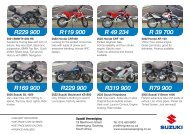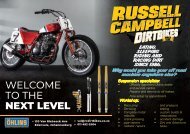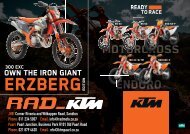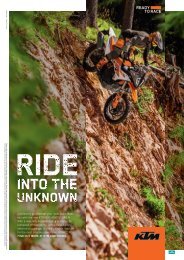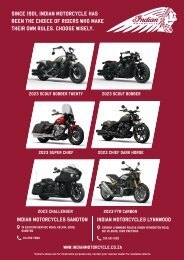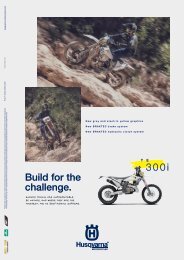RideFast JUNE 2021
Create successful ePaper yourself
Turn your PDF publications into a flip-book with our unique Google optimized e-Paper software.
This USD arrangement has two advantages: It decreases the unsprung<br />
weight of the motorcycle; and it increases torsional stiffness, which can<br />
improve handling. Two disadvantages of USD forks are they are more<br />
expensive than conventional telescopic forks; and they are liable to lose<br />
all their damping oil should an oil seal fail. USD forks are typically found<br />
on sport bikes and dirt bikes, though the Honda Valkyrie featured USD<br />
forks.<br />
TECH FEATURE<br />
SUSPENSION<br />
• Gas-charged cartridge forks, which became available in<br />
2007,consist of gas-charged cartridges fitted within standard forks.<br />
This kit is suitable for super sport and dirt bike classes of racing, where<br />
regulations prohibit a complete fork replacement but allow modification of<br />
the original forks<br />
• Other fork designs are girder forks, suspended on sprung<br />
parallel links, (not common since the 1940s)<br />
• and bottom leading link designs, not common since the 1960s.<br />
• Vincent Black Lightning with Girdraulic front suspension was a<br />
telescopic fork with a trailing linkage at the bottom attached to a form of<br />
shock absorber behind the fork and then attached to the bottom of the<br />
steering neck, early BMw’s used a similar system as well.<br />
• Some manufacturers (e.g. Greeves) used a version of the<br />
swinging arm for front suspension on their motocross designs. A singlesided<br />
version of the idea is also used in motor scooters such as the<br />
Vespa.<br />
• The hub-center steering as developed by Ascanio Rodorigo, on<br />
a concept associated to Massimo Tamburini is a complex front swingarm<br />
alternative system that entails suspension and steering, as seen in<br />
projects such as Bimota Tesi and Vyrus motorcycles.<br />
• Scott produced a motorcycle with telescopic forks in 1908 and<br />
would continue to use them until 1931<br />
• In 1935 BMW became the first manufacturer to produce a<br />
motorcycle with hydraulically damped telescopic forks<br />
• Most motorcycles today use telescopic forks for the front<br />
suspension.<br />
• A lot of high end modern motorcycle these days have electronic,<br />
reactive suspensions with factory pre set adjustments which are<br />
accessed and set by scrolling and selecting through the menu on the<br />
digital and/or TFT displays.<br />
• A lot of the heavier BMW models use a tele-lever system upfront<br />
• Dirt bikes use a range of either linkage or PDS systems, which<br />
we will look at the difference a little bit later.<br />
A NEW STANDARD OF<br />
SUSPENSION TECH<br />
WP SEMI-ACTIVE SUSPENSION (SAT): KTM and WP Suspension again set the bar in the motorcycle mar<br />
up-to-minute generation of the WP ‘SAT’. The result? More sensitivity, feedback and possibilities for persona<br />
on-the-go. Reach a new standard of comfort and improve the overall riding experience thanks to the updated<br />
Control Unit (SCU) that adjusts the damping rates with magnetic valves in real-time to react to surfaces and<br />
Stroke sensors form the basis of this advanced kit that is fully tunable from the comfort of the TFT display a<br />
switches where the rider can make adjustments for both the front and rear units individually (optional Techn<br />
Accessory). There are three different damping modes: COMFORT, STREET and SPORT as well as OFFROAD<br />
as optional extras; all using the copious data provided by the 6-axis lean angle sensor and the riding style.<br />
The KTM 1290 SUPER ADVENTURE S uses a 48 mm (200 mm of travel) WP APEX SAT fork that features a<br />
engageable (optional) anti-dive function, thus keeping the front from diving under hard braking. One innovat<br />
highlight of the SAT technology is the automatic damping mode, which adapts the damping according to the<br />
style and conditions. The electronically controlled, automatic damping option is an innovative feature develo<br />
by KTM and WP.<br />
The rear end uses the WP APEX SAT shock absorber (200 mm of wheel travel) with a completely new hydrau<br />
pre-load adjuster that is also manipulated electronically. The shock profits from a sensor delivering informat<br />
the SCU for automatic preload adjustment of the spring to achieve the ideal balance (sag) of the bike, indep<br />
weight. The preload can be adjusted by 20 mm on the <strong>2021</strong> KTM 1290 SUPER ADVENTURE S, which is a<br />
10 mm over its predecessor.<br />
In addition, the spring preload of the rear suspension can be set via the menu in 10 steps according to the r<br />
of the rider or in three automatic modes called auto leveling (optional TA) in low, standard high. The setting<br />
performed on the fly or while riding.<br />
RIDEFAST MAGAZINE <strong>JUNE</strong> <strong>2021</strong> 27






